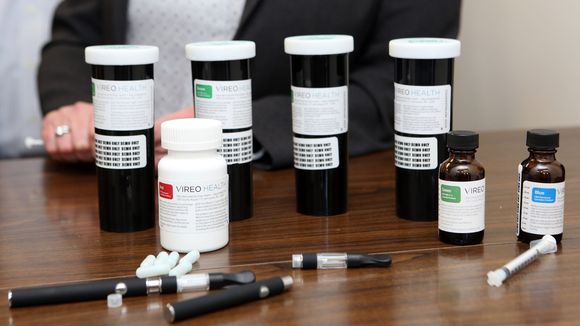Robert Celt
New Member
Each medical marijuana company in New York is allowed to produce up to five different strains of the drug. The oils, tinctures and capsules are generally labeled by different colors or brand names, and, in some cases, both.
Vireo Health of New York, for instance, uses a red, yellow and green traffic-signal-like system for three of its strains. Below is some information about the broad spectrum of marijuana-based drugs based on that traffic signal system:
Red — Has the highest amount of tetrahydrocannabinol, or THC, marijuana's psychoactive ingredient that produces the euphoric "high" feeling. These high-THC strains are being used as pain relievers, appetite stimulants and sleep aids, as well as treatments for other symptoms of cancer and neuropathy patients.
Each strain is being tested for its potential benefits for the 10 eligible illnesses in New York. Pharmacists and doctors are often mixing and matching the drugs. For example, a patient would take a high-THC strain in the evening and a less potent strain during the day to avoid feeling tired or foggy.
THC-heavy strains have also drawn push-back from doctors opposed to using the drug, especially for treating children.
These strains also influence debates over marijuana patients driving vehicles. Some patient groups are urging states to lower the minimum amount of marijuana allowed in a person's system while driving.
Currently, someone can be charged with driving under the influence of drugs several days, and in some cases weeks, after using marijuana. It remains in the blood longer than other substances that impair drivers, such as alcohol.
Yellow — Has more cannabidiol, or CBD, than the red strain. CBD is the non-psychoactive ingredient in marijuana, and is crucial in treating a range of illnesses, including epilepsy. Benefits from many of the strains, though, often overlap in treating a range of symptoms.
The difference between red and yellow is based on ratio. Generally, the strains that produce the red euphoric "high" hover around a 19:1 ratio of THC to CBD. Mid-level trains are closer to 6:1. Recreational strains are generally much higher in THC.
Each strain of medical marijuana in New York is lab tested. The state's Wadsworth Center Laboratory did the initial testing and more independent labs are expected to take over testing as the program expands.
Green — Is more within the even THC-to-CBD ratio, which each dispensary is required to sell in New York. State law also requires the dispensaries to sell a low-THC and high-CBD ratio strain, and the state Health Department has said it plans to allow more strains in the future.
A CBD-only compound is also being used in clinical studies seeking to treat epilepsy, including one underway at five different hospitals in New York.

News Moderator: Robert Celt 420 MAGAZINE ®
Full Article: NY: Medical Marijuana's Colorful Spectrum Guides Patents
Author: David Robinson
Contact: lohud
Photo Credit: Tania Savayan
Website: lohud
Vireo Health of New York, for instance, uses a red, yellow and green traffic-signal-like system for three of its strains. Below is some information about the broad spectrum of marijuana-based drugs based on that traffic signal system:
Red — Has the highest amount of tetrahydrocannabinol, or THC, marijuana's psychoactive ingredient that produces the euphoric "high" feeling. These high-THC strains are being used as pain relievers, appetite stimulants and sleep aids, as well as treatments for other symptoms of cancer and neuropathy patients.
Each strain is being tested for its potential benefits for the 10 eligible illnesses in New York. Pharmacists and doctors are often mixing and matching the drugs. For example, a patient would take a high-THC strain in the evening and a less potent strain during the day to avoid feeling tired or foggy.
THC-heavy strains have also drawn push-back from doctors opposed to using the drug, especially for treating children.
These strains also influence debates over marijuana patients driving vehicles. Some patient groups are urging states to lower the minimum amount of marijuana allowed in a person's system while driving.
Currently, someone can be charged with driving under the influence of drugs several days, and in some cases weeks, after using marijuana. It remains in the blood longer than other substances that impair drivers, such as alcohol.
Yellow — Has more cannabidiol, or CBD, than the red strain. CBD is the non-psychoactive ingredient in marijuana, and is crucial in treating a range of illnesses, including epilepsy. Benefits from many of the strains, though, often overlap in treating a range of symptoms.
The difference between red and yellow is based on ratio. Generally, the strains that produce the red euphoric "high" hover around a 19:1 ratio of THC to CBD. Mid-level trains are closer to 6:1. Recreational strains are generally much higher in THC.
Each strain of medical marijuana in New York is lab tested. The state's Wadsworth Center Laboratory did the initial testing and more independent labs are expected to take over testing as the program expands.
Green — Is more within the even THC-to-CBD ratio, which each dispensary is required to sell in New York. State law also requires the dispensaries to sell a low-THC and high-CBD ratio strain, and the state Health Department has said it plans to allow more strains in the future.
A CBD-only compound is also being used in clinical studies seeking to treat epilepsy, including one underway at five different hospitals in New York.

News Moderator: Robert Celt 420 MAGAZINE ®
Full Article: NY: Medical Marijuana's Colorful Spectrum Guides Patents
Author: David Robinson
Contact: lohud
Photo Credit: Tania Savayan
Website: lohud


